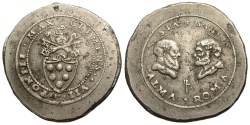Death of the Italian Renaissance
Lot 583: Papal States. Clement VII (Giulio di Giuliano de' Medici). 1523-1534. AR ducato ossidionale. 1527. 
AUCTION: Triskeles - Auction 31 (Auction 346)

- Starting Bid: $10,800
- 0 Bid(s)
Papal States. Clement VII (Giulio di Giuliano de' Medici). 1523-1534. AR ducato ossidionale (38 mm, 35.95 g, 2 h). 1527. CLEMENS · VII · · PONTIF · MAX, Medici arms surmounted by papal tiara and crossed keys / · S · PA · · S · PE ·above, · ALMA · ROMA ·, nimbate draped busts of Saints Paul and Peter confronted; low between them, VL monogram. CNI 151; Muntoni 21; Berman 832. Well centered on a reasonably round flan, with light toning and bold portraits. An extremely rare and important piece. Very fine.
Purchased by the consignor from Joel Malter, 2 September 1981.
This large silver ducat was struck at Rome specifically to pay the massive ransom imposed on Pope Clement VII after the mutinous army of the Holy Roman Emperor Charles V conquered the city in 1527, pinning the pope captive in the Castel Sant' Angelo (the fortified mausoleum of the Roman emperor, Hadrian). The ransom, 400,000 ducats, was paid in several installments over the course of the remaining year, and was accomplished by melting the gold and silver religious trappings of the Catholic Church in Rome. Assays show that these ducats contained high percentages of gold. Thus, it is not surprising that most were melted by speculators at the time hoping to profit from the constituent bullion, which explains their great rarity today. The Florentine author, Domenico de'Rossi, who was imprisoned alongside the Pope in the Castel Sant' Angelo described these ducats in his Memorie Storiche "...they were made from the candlesticks, crosses, vases and ornaments of relics [from the Church], which were imprinted with the heads of Saints Peter and Paul, and with the arms of His Holiness; they were likewise paid to those insatiable crowds."The sack of Rome in 1527 is considered the end of the Italian Renaissance. Before the sack, under the patronage of Pope Clement VII Rome had been a center for the arts, while afterward the artists had all fled. Defeated and impoverished, Clement could no longer encourage the freethinking that was a pivotal element of the Italian Renaissance: his submission to Charles V - whose religious conservatism lead to the Counterreformation and, under his successor, Philip II of Spain, the Inquisition - was total.
- Offered By: Barry P. Murphy
- Lot #: 583
- Listing #: 207159
- Closed: Friday, March 27, 2020 7:14:00 PM CT
- Estimate: $18,000

